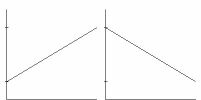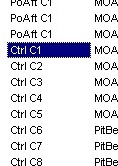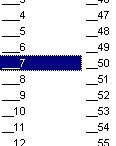
Here you can set the threshold for the control knob. A new Midistring will only be sent if the new value of the control knob differs more than the threshold value. Increase this setting to supress redundant Midi data caused by minimal fluctuations. Higher settings lower the Midi data stream and suppress undesired minimal fluctuations. The step value (see above) cannot be smaller than the treshold value.
ADC_GND/ADC_REF
The values of ADC_GND and ADC_REF define
the working range of the internal ADC (analog-to-digital converter). The 64
controls of the Drehbank cover a voltage range of 0...+5V as the rotary
potentiometers used are connected between GND and +5V. The setting for ADC_GND
or ADC_REF should be changed only if a external control voltage or foot
controller is used that covers not the whole voltage range of 0...+5V. If the
maximal or minimal data values cannot be reached the values for ADC_REF or
ADC_REF may be changed to obtain the complete data range. Especially many foot
controllers do not cover the whole voltage range as the potentiometers inside do
not turn the full cw-ccw range but only a part of the full range.
As default each variable should be assigned to represent the value of the control knob 'itself' with a range of 0...127 and a resolution of 1 digit (Step=1).
Here you can select the data format of the variable. As default each 'var' is defined as "Normal byte" which is mostly used. The bit weight notation of a normal byte is <76543210>. You have also the choice of other formats that you should only use if you know what you are doing - if you do not, it is the best way to let it be "normal byte".This setting represents the value of the assigned control knob at its left end position (ccw, fully counter clock wise). For property variables this defines the lowest available value.
This setting represents the value of the assigned control knob at its right end position (cw, fully clock wise). For property variables this defines the highest available value.
Note
You obtain an inverted control characteristic if "Range to" is lower than "Range from".

The left picture shows an example with Range from lower value f.e. 20 and Range to higher value f.e. 120. If the knob is turned from left (ccw) to right (cw) the data 20...120 are generated.
The right picture shows an example with Range from higher value f.e 120 and Range to lower value f.e 20. If the knob is turned from left (ccw) to right (cw) the data 120...20 are generated. The characteristics is reverse compared to the first example.
Here you set the step resolution of the corresponding control value. As default step is set to 1 for having the full resolution. The 4 pictures show increasing values for the step parameter. The step value cannot be less than the Threshold value.


With the SoundDiver-Editor you can not work with 'complete' / 'ready made' events/macros for the Drehbank as you can do this with the special PC editor program.
F.e. if you want to assign a midi controller event for a knob you cannot
select a ready made controller event from a pulldown menu.
In contrast to this 'easy' way you have to know exactly how a controller event
is defined and then you have to create this very basic format.(*)
F.e. a controller event consist of a byte string of 3 bytes and to define/assing
a certain controller event you have to contstruct this midistring and edit the
right positions in the midistring dialog puilldown menus in the SoundDiver
editor.
(* We recommend to be familiar with the midi basic, the midi specification and the midi data format.)
You want to generate a Midicontroller Event which send on channel 1 Controllernumber 0 with the controller value of the drehbank knob.
The format of the Event is:
ControllerEvent-Channel1, Value00 , XX
(where XX is a value 0..127 coming from ther position of the knob)
The first Byte of the Event is
(Position 1):
ControllerEvent-Channel1

Click on the item on position 1
and select 'Ctrl C1' from the menu, whcih is a shortcut for 'Controller on
channel 1' .... f.e. 'Ctrl C16' means Controller Channel 16.
PRG is the Shortcut for ProgrammChange, MoAft for Monophonic
Aftertouch
a.s.o.
Nr0
Now you've defined that the event will be
a controller event you ahve to defefine which controller number (0-127) you
want.
So the second Byte of the Event is
(Position 2):
Value00

F.e. '7' which is defined in the midispec as the volume controller.
Now it's time to put a changeable
value into the string in contrast to teh last two fixed values.
Past all that this value sould be defined by the position of the assigned knob.
So the third Byte of the Event is (Position 3):
variable value from the drehbank knob

With SoundDiver and drehbank you can define a midistring with maximum 48
bytes.
Normal midievents need 2 or 3 bytes so you must define the position in the
string, where the drehbank stops transmission of this midistring.
(F.e. if you delete the end marker at position 4 drehbank will send evey time
the knob is move a byte string of 48 bytes. Starts with the well defined Volume
controller and after that 44 Bytes with the value '0'.)

So to stop drehbank sending bytes after the third you must set on the Position 4
a Stop-Marker END.
Because of the 'end' marker the reaming bytes (Position 5 - 48) will not be send and are so 'don't care'.
With the "Store to EEPROM" button you copy the complete preset into
the non-volatile memory (EEPROM) of the Drehbank. This takes about max. 82
seconds. During this eternity the L.E.D. will blink constantly.
During this time the drehbank you should not send any new datas to the drehbank
because the drehbank will not recognize this or maybe this will cause an error.
Here you can define a name for this Drehbank string ( 12 Chars)
This is only need if you build a string with a checksum in it. here you can define the type if the checksum.